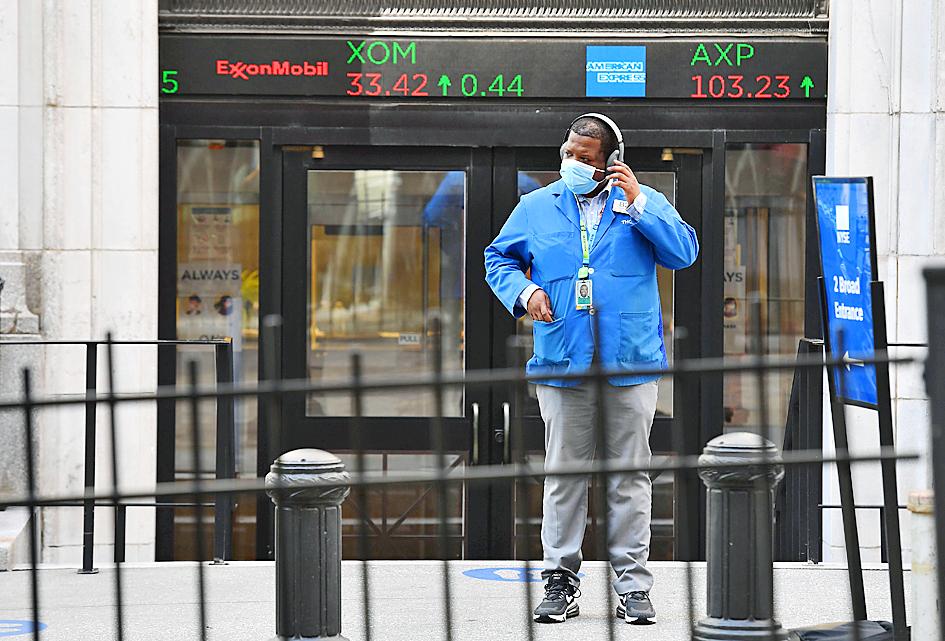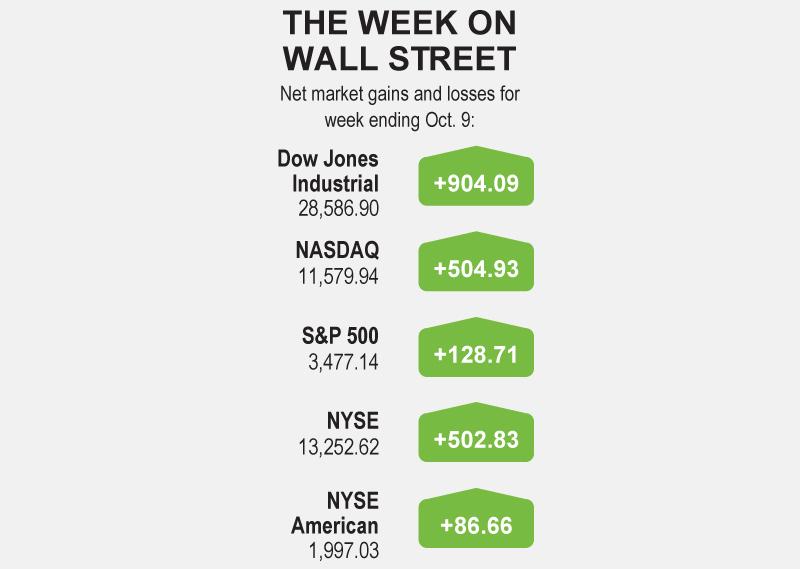US stocks rose on Friday and the S&P 500 and the NASDAQ Composite registered their biggest weekly percentage gains since July as optimism over more federal fiscal aid grew.
Talks were expected to continue on a COVID-19 stimulus package, even though US House of Representatives Speaker Nancy Pelosi and US Secretary of the Treasury Steven Mnuchin on Friday failed to reach agreement.
Mnuchin floated a new proposal in the afternoon, but an aide for Pelosi said it lacked a broad plan to contain the pandemic.

Photo: AFP
Recent trading on Wall Street has been dictated by headlines on fiscal aid, with the three main indices tumbling on Tuesday after US President Donald Trump called off negotiations. He has since indicated he was willing to resume discussions.
“The market’s reacting well to Trump’s sudden turnaround in terms of a support package,” said Tim Ghriskey, chief investment strategist at Inverness Counsel Inc in New York City. “A lot of this has been politics, but a lot of people believe the economy really needs some economic support here, so that’s a good thing.”
The S&P 500 technology shares rose 1.5 percent, and the sector gave the S&P 500 its biggest boost.

Graphic: AP
The small-cap Russell 2000 index climbed 6.4 percent for the week, posting its biggest percentage gain since early June.
The Dow Jones Industrial Average rose 161.39 points, or 0.57 percent, to 28,586.9, the S&P 500 gained 30.31 points, or 0.88 percent, to 3,477.14 and the NASDAQ Composite added 158.96 points, or 1.39 percent, to 11,579.94.
For the week, the S&P 500 rose 3.8 percent and the NASDAQ climbed 4.6 percent, their biggest weekly percentage gains since July. The Dow added 3.3 percent, its biggest weekly gain since August.
Strategists have said investors have also begun to digest the possibility of former US vice president Joe Biden, the Democratic Party’s presidential candidate, winning the Nov. 3 US presidential election after a fractious debate last month led to a jump in his lead over Trump in several national polls.
Xilinx Inc surged 14.1 percent after a report said Advanced Micro Devices Inc was in talks to buy the chipmaker in a deal valued at more than US$30 billion.
General Electric Co rose 2.9 percent as a report said Goldman Sachs reinstated coverage on the US industrial conglomerate with a “buy” rating, saying the company would emerge stronger from the COVID-19 pandemic.
The S&P 500 energy index fell 1.6 percent following recent gains.
Advancing issues outnumbered declining ones on the New York Stock Exchange by a 1.30-to-1 ratio; on NASDAQ, a 1.42-to-1 ratio favored advancers.
The S&P 500 posted 76 new 52-week highs and one new low; the NASDAQ Composite recorded 141 new highs and 18 new lows.
Volume on US exchanges was 8.92 billion shares, compared with the 9.76 billion average for the full session over the past 20 trading days.

SEEKING CLARITY: Washington should not adopt measures that create uncertainties for ‘existing semiconductor investments,’ TSMC said referring to its US$165 billion in the US Taiwan Semiconductor Manufacturing Co (TSMC, 台積電) told the US that any future tariffs on Taiwanese semiconductors could reduce demand for chips and derail its pledge to increase its investment in Arizona. “New import restrictions could jeopardize current US leadership in the competitive technology industry and create uncertainties for many committed semiconductor capital projects in the US, including TSMC Arizona’s significant investment plan in Phoenix,” the chipmaker wrote in a letter to the US Department of Commerce. TSMC issued the warning in response to a solicitation for comments by the department on a possible tariff on semiconductor imports by US President Donald Trump’s

The government has launched a three-pronged strategy to attract local and international talent, aiming to position Taiwan as a new global hub following Nvidia Corp’s announcement that it has chosen Taipei as the site of its Taiwan headquarters. Nvidia cofounder and CEO Jensen Huang (黃仁勳) on Monday last week announced during his keynote speech at the Computex trade show in Taipei that the Nvidia Constellation, the company’s planned Taiwan headquarters, would be located in the Beitou-Shilin Technology Park (北投士林科技園區) in Taipei. Huang’s decision to establish a base in Taiwan is “primarily due to Taiwan’s talent pool and its strength in the semiconductor

An earnings report from semiconductor giant and artificial intelligence (AI) bellwether Nvidia Corp takes center stage for Wall Street this week, as stocks hit a speed bump of worries over US federal deficits driving up Treasury yields. US equities pulled back last week after a torrid rally, as investors turned their attention to tax and spending legislation poised to swell the US government’s US$36 trillion in debt. Long-dated US Treasury yields rose amid the fiscal worries, with the 30-year yield topping 5 percent and hitting its highest level since late 2023. Stocks were dealt another blow on Friday when US President Donald

UNCERTAINTY: Investors remain worried that trade negotiations with Washington could go poorly, given Trump’s inconsistency on tariffs in his second term, experts said The consumer confidence index this month fell for a ninth consecutive month to its lowest level in 13 months, as global trade uncertainties and tariff risks cloud Taiwan’s economic outlook, a survey released yesterday by National Central University found. The biggest decline came from the timing for stock investments, which plunged 11.82 points to 26.82, underscoring bleak investor confidence, it said. “Although the TAIEX reclaimed the 21,000-point mark after the US and China agreed to bury the hatchet for 90 days, investors remain worried that the situation would turn sour later,” said Dachrahn Wu (吳大任), director of the university’s Research Center for